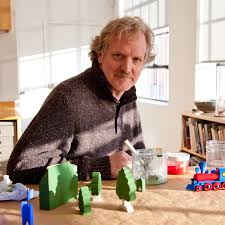
Biography
Walter Wick (1953 - ) is an American artist, photographer, and author best known for his two series of picture activity books for children: I Spy and Can You See What I See?, both published by Scholastic. 1 During his career, he has also photographed hundreds of mass-market magazine covers.
A native of Hartford, Connecticut, Wick was raised in rural East Granby, Connecticut and attended East Granby High School, already pursuing an interest in art and photography. In 1973, he completed a two-year course with an emphasis on landscape photography at Paier School of Art in Hamden, Connecticut. 2 After graduating from Paier, Wick began a five-year stint as a commercial photographer, employed by a studio in Hartford, Connecticut. In 1978 he moved to New York City with Linda Cheverton. A year later, he set up his own studio on West 23rd Street.
Wick married Linda Cheverton in 1980 and shifts his focus from commercial product photography to photo illustration for books and magazines while his wife, Linda, embarks on a career as a photo stylist. Wick completed hundreds of assignments for magazine and book publishers during the 1980s, and his first photographic puzzle, “The Amazing Mirror Maze,” was published in Games magazine in 1981.
Wick’s clients in the 1980s included publications like Psychology Today, Discover, and Newsweek, among others. 3 During this period, he also designed many photographic puzzles for Games magazine. While photography became Wick’s chosen medium, the true art form and talent that emerged from his work is the meticulous arrangement of found objects and hand-crafted dioramas he says he often imagined in his unstructured free-form hours of childhood play.
While juggling commercial assignments for magazine and book publishers, Wick continued to do cover illustrations and puzzle designs for Games. It was during this time that he worked on photographs for a “fasteners” poster for Let’s Find Out, a kindergarten magazine edited by Jean Marzollo and designed by Carol Devine Carson. The poster eventually became the inspiration for I SPY. 4
Wick moved his studio to Broadway in Manhattan and was keeping busy with his magazine and book publishers’ assignments when in 1991 he met with Jean Marzollo, Carol Devine Carson, and Scholastic editors to discuss an idea for a photographic-search-and-find book to be called I SPY. Wick shot the pictures for the first I SPY book and, around that time, decided to move his studio to Winsted, Connecticut.
During the 1990s the first I SPY book became a commercial success, spawning eight original titles and numerous compilations and spinoffs. A Drop of Water: A Book of Science and Wonder published in 1996 won the Boston Globe-Horn Book first prize for nonfiction; and Wick’s 1998 Optical Tricks was chosen as one of the year’s “best illustrated children’s books” by The New York Times. In 2002 Can You See What I See?, the first of Wick’s new series of picture puzzle books, is published and remained on The New York Times best-seller list for 22 weeks.
Returning to Connecticut in 2004, Wick and his wife, Linda, purchased and renovated a Hartford Fire Department maintenance building for his new studio. Wick enjoys collecting props from vintage and antique shops wherever he finds himself and his books often start off with an inspiration from an object or set of objects. In Connecticut, he continued with the Can You See What I See? series and held his first major museum exhibition, Games, Gizmos and Toys in the Attic, at the New Britain Museum of American Art in 2006. The exhibition traveled to ten more venues around the United States.
Since 2014 Wick and his wife live and work in Miami, Florida. He has published A Ray of Light: A Book of Science and Wonder (2019) and two Can You See What I See? titled: Hidden Wonders (2019) and Curiosity Shop (2021 edition, Japan) and (2024 edition, United States). 5 Wick continues his love for tinkering, photography, and creating picture books at his studio in Miami’s Wynwood arts district.
Footnotes:
1. Wikipedia’s entry on Walter Wick. Accessed on April 17, 2025. https://en.wikipedia.org/wiki/Walter_Wick
2. Walter Wick's Artist Statement
3. Walter Wick Studio website. Accessed on April 17, 2025 https://www.walterwick.com/about
4. Artist Statement presented to the Norman Rockwell Museum on ____
5. Walter Wick Studio website. Accessed on April 17, 2025 https://www.walterwick.com/about
This essay was written by Phyllis Geraghty, a writer with professional experience in the public relations, education, health, and non-profit sectors.
Illustrations by Walter Wick
Additional Resources
Bibliography
Walter Wick's Artist Statement
Walter Wick Studio website. Accessed on April 17, 2025 https://www.walterwick.com/about
Wikipedia’s entry on Walter Wick. Accessed on April 17, 2025. https://en.wikipedia.org/wiki/Walter_Wick















